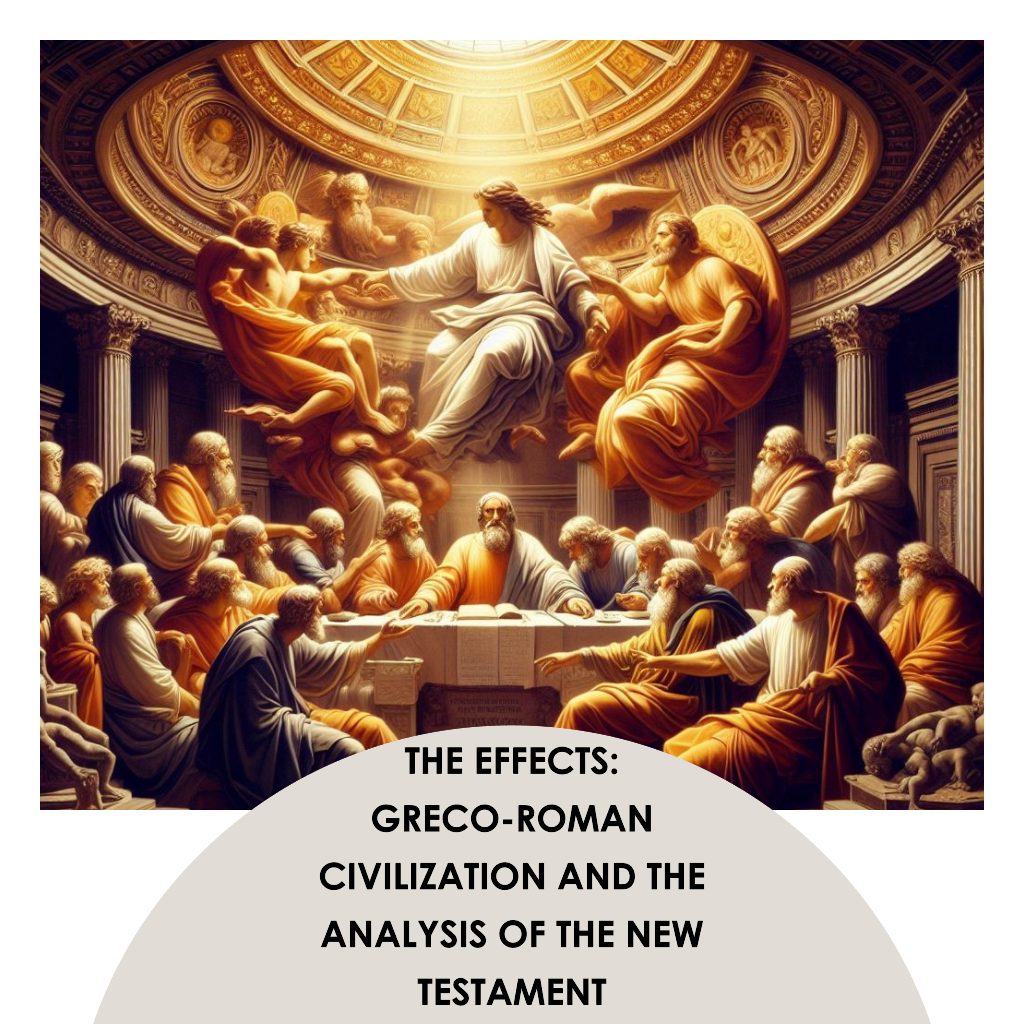Written by Lesallan – April 22, 2024

The Effects: Greco-Roman Civilization and the Analysis of the New Testament
Lesallan Bostron
Ohio Christian University
BIB2025 New Testament Interpretation (ONLSP24)
Professor Matthew Benson
April 22, 2024
The Effects: Greco-Roman Civilization and the Analysis of the New Testament
The emergence of Christianity from the roots of Judaism was a significant event in the history of the ancient world, marking the beginning of a new religious movement that would eventually become one of the dominant faiths in the Western world. However, the early Christian movement faced a complex and diverse mission field in the Greco-Roman world, where it had to navigate the intricate social, cultural, and religious landscape of the time. This paper explores the influence of three critical elements of Greco-Roman culture – religion, patronage, and family/household – on interpreting the New Testament. The aim (the thesis) of this paper is that understanding these elements of Greco-Roman culture is crucial for a nuanced interpretation of the New Testament, as they provide a context that brings to light the subtleties and complexities of the New Testament text. This paper explores the historical, social, and the cultural background in which the New Testament was written by analyzing the role of religion, patronage, and family/household in the Greco-Roman society and their impact on the early Christian movement. The objective is to provide a deeper understanding of the meaning and significance of the New Testament.
The first century CE Greco-Roman world was a complex and diverse cultural milieu characterized by a rich tapestry of religious beliefs and practices. From the worship of traditional deities to the enigmatic mystery cults and philosophical schools, this intricate religious landscape provided a fertile ground for the emergence and spread of various religious ideas and practices. It is against this backdrop that the New Testament was written and interpreted. The concept of divine intervention, for instance, which is a central theme in the New Testament, can be better understood when viewed against the backdrop of the Greco-Roman religious beliefs that emphasized the role of the gods in human affairs. Similarly, the use of miracles in the New Testament can be seen as a response to the Greco-Roman religious context, where miracles were often attributed to the intervention of the gods. In particular, the miracles performed by Jesus can be seen as a challenge to the divine claims of the Roman emperors and the gods of the Greco-Roman pantheon. By performing miracles, Jesus demonstrated his divine authority and power, challenging the claims of other divine figures in the Greco-Roman world. It is, therefore, essential to understand the rich and diverse religious context of the Greco-Roman world to fully appreciate the religious ideas and practices of the New Testament. The New Testament’s use of miracles to demonstrate divine power can be seen as a direct challenge to the Greco-Roman pantheon. However, it also served as a means of communication with the people of that time. Miracles were a language that the people understood and respected, making them an effective tool for spreading the Christian message.
In the Greco-Roman world, patronage was a complex social and economic system that governed the relationships between patrons, typically individuals of wealth and influence, and clients, who were recipients of the patron’s favors. In this system, patrons were obligated to provide protection, financial support, and other assistance to their clients in return for unwavering loyalty, valuable services, and utmost respect. The patronage system was deeply ingrained in the social fabric of the ancient world, and it played a critical role in shaping economic, political, and cultural interactions between individuals and groups.
The patronage system also significantly impacted early Christianity’s development, as evidenced by several New Testament passages. For instance, the parable of the unjust steward in Luke 16:1-13 can be seen as a scathing critique of the patronage system prevalent in the society of that time. The steward, who is accused of squandering his master’s property, can be interpreted as a symbol of the patrons who abused their power and wealth at the expense of their clients. The parable highlights the ethical complexities of the patronage system and the tension between economic interests and moral values. Overall, the patronage system was a fundamental aspect of ancient social and economic life, and it continues to be an essential subject of scholarly inquiry and debate. The New Testament’s critique of the patronage system can also be seen as a call for a new relationship based on equality and mutual respect. This patronage system is particularly evident in the teachings of Jesus, who consistently advocated for the poor and marginalized, challenging the social norms of the time.
In the Greco-Roman world, the household structure was intricate and dominated by the paterfamilias, the male head. This hierarchical system was deeply ingrained in the social fabric of the time, and household codes were used to regulate the behavior of family members. In the New Testament, the household codes in Ephesians 5:22-6:9 reflect this typical household structure, but they also offer a unique Christian perspective on these relationships. These passages instruct husbands, wives, children, and enslaved people, which can be seen as a radical redefinition of the roles and responsibilities within the Greco-Roman household. At the heart of this redefinition is the emphasis on mutual respect and love, which starkly contrasts with the hierarchical authority that characterized the Greco-Roman world. By highlighting the importance of treating all household members with dignity and compassion, these passages reflect a distinctively Christian approach to social relations that challenged the prevailing norms of the time. The New Testament’s redefinition of household roles challenged the Greco-Roman norms and radically reimagined society. By emphasizing mutual respect and love within the household, the New Testament laid the groundwork for a community that values every member equally, regardless of their social status.
In contemporary biblical scholarship, it is widely acknowledged that a nuanced interpretation of the New Testament requires understanding the critical elements of Greco-Roman culture that were prevalent during its composition. These fundamental elements include religion, patronage, and family/household, and they provide a socio-cultural context essential for comprehending the subtleties and complexities of the text. Through carefully examining these elements, scholars can gain a deeper understanding of how the New Testament interacted with and challenged the cultural norms of its time.
Religion was an integral aspect of Greco-Roman culture, and this is evident in the New Testament’s use of religious terminology, imagery, and concepts. The New Testament writers were steeped in the religious traditions of their time, and they often drew on these traditions to convey their message. For example, the concept of salvation in the New Testament is deeply rooted in the religious traditions of the Greco-Roman world, particularly in the idea of a savior figure who would deliver people from their sins.
Patronage was another critical element of Greco-Roman culture, and it played an essential role in the social and economic relationships of the time. The New Testament writers frequently used patronage language and concepts to describe the relationship between God and humanity and the relationships between individuals within the Christian community. Understanding the dynamics of patronage is essential for comprehending the New Testament’s teachings on social justice, reciprocity, and generosity.
Finally, family/household was a fundamental institution in Greco-Roman culture, and it played a significant role in shaping social relationships and power dynamics. The New Testament writers frequently used family/household language and concepts to describe the relationship between God and humanity and relationships between individuals within the Christian community. Understanding the dynamics of family/household is essential for comprehending the New Testament’s teachings on gender roles, social hierarchy, and community life.
In the Greco-Roman world, women were often relegated to the background. However, in the New Testament, we see women playing significant roles, from Mary, the mother of Jesus, to the women who were the first to witness the resurrection. This, written in the New Testament, highlights the New Testament’s revolutionary nature in its cultural context.
The New Testament introduced a new kind of love – agape or selfless love. This kind of love was a radical departure from the Greco-Roman understanding of love and has profoundly impacted Western culture and thought.
In summary and, conclusion, a nuanced interpretation of the New Testament requires carefully considering the critical elements of Greco-Roman culture that were prevalent during its composition. By examining the religious, patronage, and the family/household dynamics of this cultural context, scholars can gain a deeper understanding of the socio-cultural context in which the New Testament was written and how it interacted with and challenged the norms of its time. The New Testament is not just a religious text, but also a historical document that reflects the socio-cultural context of its time. By understanding this context, we can better appreciate the New Testament’s revolutionary nature and its enduring impact on today’s world.
References:
Evans, C. A., Porter, S. E., & Evans, G. (2000). Dictionary of New Testament background.
Intervarsity Press, Cop.

